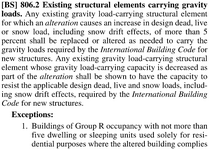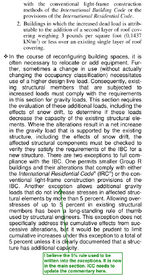My understanding based on previous editions of the IEBC is that the 5% increase was based on the total gravity load. The wording in the more current versions, however, could be read as 5% of the load type, i.e. dead, live, or snow.
“Any existing gravity load-carrying structural element for which an alteration causes an increase in design dead, live or snow load, including snow drift effects, of more than 5 percent shall be replaced or altered…”
How do you guys read this?
“Any existing gravity load-carrying structural element for which an alteration causes an increase in design dead, live or snow load, including snow drift effects, of more than 5 percent shall be replaced or altered…”
How do you guys read this?



